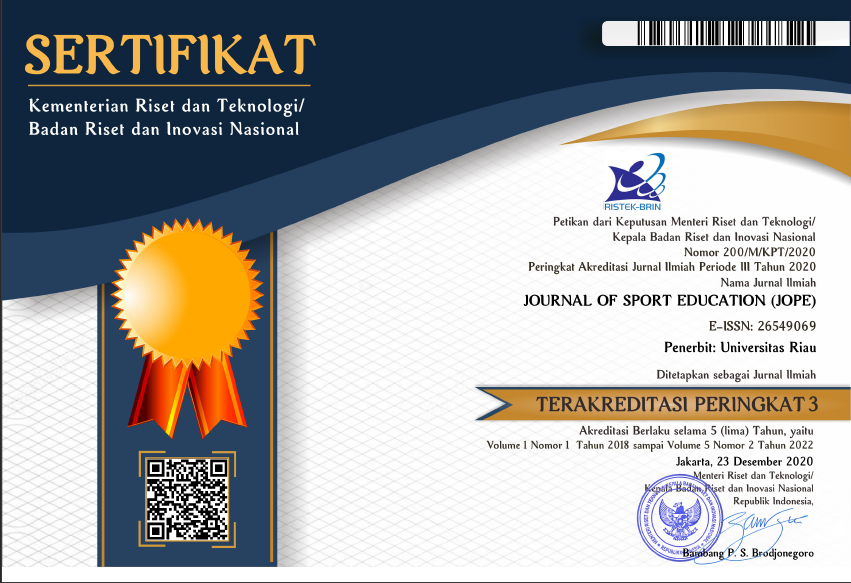Tingkat stress calon guru pendidikan jasmani selama pandemi covid-19
Abstract
Copyright © The Author (s) 2022

Keywords
Full Text:
PDF (Bahasa Indonesia)References
Acharya, L., Jin, L., & Collins, W. (2018). College life is stressful today–Emerging stressors and depressive symptoms in college students. Journal of American College Health, 66(7), 655–664. https://doi.org/10.1080/07448481.2018.1451869
Al-Tammemi, A. B. (2020). The Battle Against COVID-19 in Jordan: An Early Overview of the Jordanian Experience. Frontiers in Public Health, 8, 188. https://doi.org/10.3389/fpubh.2020.00188
Araújo, F. J. de O., de Lima, L. S. A., Cidade, P. I. M., Nobre, C. B., & Neto, M. L. R. (2020). Impact Of Sars-Cov-2 And Its Reverberation In Global Higher Education And Mental Health. Psychiatry Research, 288, 112977. https://doi.org/10.1016/j.psychres.2020.112977
Bayu, W. I., Syafaruddin, S., Yusfi, H., Syamsuramel, S., Solahuddin, S., & Victorian, A. R. (2021). Gambaran aktivitas fisik dan indeks massa tubuh calon guru pendidikan jasmani selama pandemi Covid-19. Multilateral : Jurnal Pendidikan Jasmani Dan Olahraga, 20(2), 130. https://doi.org/10.20527/multilateral.v20i2.10394
Benke, C., Autenrieth, L. K., Asselmann, E., & Pané-Farré, C. A. (2020). Lockdown, quarantine measures, and social distancing: Associations with depression, anxiety and distress at the beginning of the COVID-19 pandemic among adults from Germany. Psychiatry Research, 293. https://doi.org/10.1016/J.PSYCHRES.2020.113462
Brooks, S. K., Webster, R. K., Smith, L. E., Woodland, L., Wessely, S., Greenberg, N., & Rubin, G. J. (2020). The psychological impact of quarantine and how to reduce it: rapid review of the evidence. The Lancet, 395(10227), 912–920. https://doi.org/10.1016/S0140-6736(20)30460-8
Bruffaerts, R., Mortier, P., Kiekens, G., Auerbach, R. P., Cuijpers, P., Demyttenaere, K., Green, J. G., Nock, M. K., & Kessler, R. C. (2018). Mental health problems in college freshmen: Prevalence and academic functioning. Journal of Affective Disorders, 225, 97–103. https://doi.org/10.1016/j.jad.2017.07.044
Cao, W., Fang, Z., Hou, G., Han, M., Xu, X., Dong, J., & Zheng, J. (2020). The psychological impact of the COVID-19 epidemic on college students in China. Psychiatry Research, 287, 112934. https://doi.org/10.1016/j.psychres.2020.112934
Chakraborty, I., & Maity, P. (2020). COVID-19 outbreak: Migration, effects on society, global environment and prevention. Science of the Total Environment, 728, 138882. https://doi.org/10.1016/j.scitotenv.2020.138882
Chang, J., Yuan, Y., & Wang, D. (2020). Mental health status and its influencing factors among college students during the epidemic of COVID-19. Nan Fang Yi Ke Da Xue Xue Bao = Journal of Southern Medical University, 40(2), 171–176. https://doi.org/10.12122/j.issn.1673-4254.2020.02.06
Darisman, E. K., Prasetiyo, R., & Bayu, W. I. (2021). Belajar Psikologi Olahraga: Sebuah Teori dan Aplikasi dalam Olahraga. Jakad Media Publishing.
Dewantara, J. A., & Nurgiansah, T. H. (2020). Efektivitas Pembelajaran Daring di Masa Pandemi COVID 19 Bagi Mahasiswa Universitas PGRI Yogyakarta. Jurnal Basicedu, 5(1), 367–375. https://doi.org/10.31004/basicedu.v5i1.669
Diniz, B. S., Reynolds, C. F., Butters, M. A., Dew, M. A., Firmo, J. O. A., Lima-Costa, M. F., & Castro-Costa, E. (2014). The effect of gender, age, and symptom severity in late-life depression on the risk of all-cause mortality: The Bambuí cohort study of aging. Depression and Anxiety, 31(9), 787–795. https://doi.org/10.1002/DA.22226
Easton, S. D., Safadi, N. S., Wang, Y., & Hasson, R. G. (2017). The Kessler psychological distress scale: Translation and validation of an Arabic version. Health and Quality of Life Outcomes, 15(1), 215. https://doi.org/10.1186/s12955-017-0783-9
Fitzpatrick, O., Biesma, R., Conroy, R. M., & McGarvey, A. (2019). Prevalence and relationship between burnout and depression in our future doctors: A cross-sectional study in a cohort of preclinical and clinical medical students in Ireland. BMJ Open, 9(4), e023297. https://doi.org/10.1136/bmjopen-2018-023297
Ho, C. S., Chee, C. Y., & Ho, R. C. (2020). Mental Health Strategies to Combat the Psychological Impact of COVID-19 Beyond Paranoia and Panic. Annals of the Academy of Medicine, Singapore, 49(1), 1–3. http://www.ncbi.nlm.nih.gov/pubmed/32200399
Holmes, E. A., O’Connor, R. C., Perry, V. H., Tracey, I., Wessely, S., Arseneault, L., Ballard, C., Christensen, H., Cohen Silver, R., Everall, I., Ford, T., John, A., Kabir, T., King, K., Madan, I., Michie, S., Przybylski, A. K., Shafran, R., Sweeney, A., … Bullmore, E. (2020). Multidisciplinary research priorities for the COVID-19 pandemic: a call for action for mental health science. The Lancet Psychiatry, 7(6), 547–560. https://doi.org/10.1016/S2215-0366(20)30168-1
Ikhsan, M. (2020). Efektivitas Pembelajaran Berbasis Daring pada Mata Kuliah Profesi Kependidikan. Jurnal Ilmiah IKIP Mataram, 7(2), 254–261. https://ojs.ikipmataram.ac.id/index.php/jiim/article/view/3394
Kakaje, A., Al Zohbi, R., Hosam Aldeen, O., Makki, L., Alyousbashi, A., & Alhaffar, M. B. A. (2021). Mental disorder and PTSD in Syria during wartime: a nationwide crisis. BMC Psychiatry, 21(1), 2. https://doi.org/10.1186/s12888-020-03002-3
Lai, J., Ma, S., Wang, Y., Cai, Z., Hu, J., Wei, N., Wu, J., Du, H., Chen, T., Li, R., Tan, H., Kang, L., Yao, L., Huang, M., Wang, H., Wang, G., Liu, Z., & Hu, S. (2020). Factors associated with mental health outcomes among health care workers exposed to coronavirus disease 2019. JAMA Network Open, 3(3). https://doi.org/10.1001/JAMANETWORKOPEN.2020.3976
Lawton, G. (2020). How do we leave lockdown? New Scientist, 246(3277), 10–12. https://doi.org/10.1016/s0262-4079(20)30706-5
Liu, X., Liu, J., & Zhong, X. (2020). Psychological State of College Students During COVID-19 Epidemic. SSRN Electronic Journal. https://doi.org/10.2139/ssrn.3552814
Ma, Z., Zhao, J., Li, Y., Chen, D., Wang, T., Zhang, Z., Chen, Z., Yu, Q., Jiang, J., Fan, F., & Liu, X. (2020). Mental health problems and correlates among 746 217 college students during the coronavirus disease 2019 outbreak in China. Epidemiology and Psychiatric Sciences. https://doi.org/10.1017/S2045796020000931
Mukhtar, S. (2020). Psychological health during the coronavirus disease 2019 pandemic outbreak. International Journal of Social Psychiatry, 66(5), 512–516. https://doi.org/10.1177/0020764020925835
Mylsidayu, A. (2021). Stress level of physical education students: How to do the learning during the covid-19 pandemic? Journal Sport Area, 6(1), 148–160. https://doi.org/10.25299/sportarea.2021.vol6(1).5729
Nahas, A. R. M. F., Elkalmi, R. M., Al-Shami, A. M., & Elsayed, T. M. (2019). Prevalence of depression among health sciences students: Findings from a public university in Malaysia. Journal of Pharmacy and Bioallied Sciences, 11(2), 170–175. https://doi.org/10.4103/JPBS.JPBS_263_18
Ornell, F., Schuch, J. B., Sordi, A. O., & Kessler, F. H. P. (2020). ‘“Pandemic fear”’ and COVID-19: Mental health burden and strategies. Brazilian Journal of Psychiatry, 42(3), 232–235. https://doi.org/10.1590/1516-4446-2020-0008
Oryan, Z., Avinir, A., Levy, S., Kodesh, E., & Elkana, O. (2021). Risk and protective factors for psychological distress during COVID-19 in Israel. Current Psychology (New Brunswick, N.J.), 1–12. http://www.ncbi.nlm.nih.gov/pubmed/34248314
Ripoll, J., Contreras-Martos, S., Esteva, M., Soler, A., & Serrano-Ripoll, M. J. (2021). Mental Health and Psychological Wellbeing during the COVID-19 Lockdown: A Longitudinal Study in the Balearic Islands (Spain). Journal of Clinical Medicine, 10(14), 3191. https://doi.org/10.3390/jcm10143191
Shivayogi, P. (2013). Vulnerable population and methods for their safeguard. Perspectives in Clinical Research, 4(1), 53. https://doi.org/10.4103/2229-3485.106389
Son, C., Hegde, S., Smith, A., Wang, X., & Sasangohar, F. (2020). Effects of COVID-19 on college students’ mental health in the United States: Interview survey study. Journal of Medical Internet Research, 22(9), 1–14. https://doi.org/10.2196/21279
Victorian, A. R., Aryanti, S., Yusfi, H., Solahuddin, S., & Bayu, W. I. (2021). Perspektif calon guru pendidikan jasmani terhadap pembelajaran online selama pandemi Covid-19. Journal of Sport Science and Education) |, 6(1), 94–106. https://doi.org/10.26740/jossae.v6n1.p94-106
Waisel, D. B. (2013). Vulnerable populations in healthcare. Current Opinion in Anaesthesiology. https://doi.org/10.1097/ACO.0b013e32835e8c17
Wang, C., & Zhao, H. (2020). The Impact of COVID-19 on Anxiety in Chinese University Students. Frontiers in Psychology, 11. https://doi.org/10.3389/fpsyg.2020.01168
Wu, S., Zhang, K., Parks-Stamm, E. J., Hu, Z., Ji, Y., & Cui, X. (2021). Increases in Anxiety and Depression During COVID-19: A Large Longitudinal Study From China. Frontiers in Psychology, 12. https://doi.org/10.3389/FPSYG.2021.706601
Xie, X., Xue, Q., Zhou, Y., Zhu, K., Liu, Q., Zhang, J., & Song, R. (2020). Mental health status among children in home confinement during the coronavirus disease 2019 outbreak in Hubei Province, China. JAMA Pediatrics, 174(9), 898–900. https://doi.org/10.1001/jamapediatrics.2020.1619
Zeng, Y., Wang, G., Xie, C., Hu, X., & Reinhardt, J. D. (2019). Prevalence and correlates of depression, anxiety and symptoms of stress in vocational college nursing students from Sichuan, China: a cross-sectional study. Psychology, Health and Medicine. https://doi.org/10.1080/13548506.2019.1574358
Zhai, Y., & Du, X. (2020a). Mental health care for international Chinese students affected by the COVID-19 outbreak. The Lancet Psychiatry, 7(4), e22. https://doi.org/10.1016/S2215-0366(20)30089-4
Zhai, Y., & Du, X. (2020b). Addressing collegiate mental health amid COVID-19 pandemic. Psychiatry Research, 288, 113003. https://doi.org/10.1016/j.psychres.2020.113003
DOI: http://dx.doi.org/10.31258/jope.4.2.87-96
Refbacks
- There are currently no refbacks.











